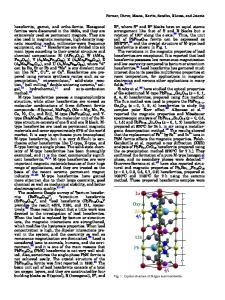Structural characterization, dielectric, and magnetic properties of Ti-doped YFeO 3 multiferroic compound
- PDF / 4,596,965 Bytes
- 9 Pages / 595.276 x 790.866 pts Page_size
- 98 Downloads / 317 Views
Structural characterization, dielectric, and magnetic properties of Ti‑doped YFeO3 multiferroic compound M. Solórzano1 · A. Durán2 · R. López3 · J. Mata4 · R. Falconi1 Received: 20 March 2020 / Accepted: 13 July 2020 © Springer Science+Business Media, LLC, part of Springer Nature 2020
Abstract Crystal structure, and magnetic and dielectric properties were studied in Ti-doped Y FeO3 polycrystalline samples. The crystal structure and chemical state of the Fe/Ti cations were characterized by a combination of X-ray diffraction (XRD) and X-ray photoelectron spectroscopy (XPS). It is found that a narrow solid-solubility limit is achieved (~ 6%) and the d0–ness of T i4+ is not favored in the YFeO3 matrix. A change in the valence states of Fe and Ti cations explains not only the low solubility limit but also the anomalous increase of the volume cell. Soft magnetic hysteresis curves in the M vs H curves indicate that the weak ferromagnetic contribution prevails for all the studied samples. Furthermore, by means of differential calorimetry (DSC) it was possible to identify the AFM transition which decreases with increasing Ti content. On the other hand, the change of the step-like anomaly to a broad peak in the permittivity (ε′) and loss tangent (tan δ) as Ti content increases resemble to a relaxor ferroelectric transition. The endothermic peak (DSC) around the magnetic transition and the broad peaks in the ε′(T) data seem to indicate the existence of a local polarization coupled with AFM transition at ~ 650 K. Two types of charge carriers were found in the doped systems, oxygen vacancies at high temperatures, and small polarons at low temperatures, respectively. Besides, it is found that the introduction of those charge carriers in the YFeO3 matrix occurs by the change of oxidation state from Fe3+ to Fe2+ through Ti3+.
1 Introduction In recent years, orthoferrites family has attracted great attention due to their complex magnetic and electric properties [1–3]. Multiferroics properties lead to multifunctional materials through interlinked magnetic and electric polarization * M. Solórzano [email protected] 1
División Académica de Ciencias Básicas, Universidad Juárez Autónoma de Tabasco, Carretera Cunduacán‑Jalpa de Méndez Km 1. Col. La Esmeralda, Apartado Postal 24, C.P. 86690 Cunduacán, Tabasco, México
2
Centro de Nanociencias y Nanotecnología, Universidad Nacional Autónoma de México, Km. 107 Carretera Tijuana‑Ensenada, Apartado Postal 14, C.P. 22800 Ensenada, BC, Mexico
3
División Académica de Ingeniería y Arquitectura, Universidad Juárez Autónoma de Tabasco, Carretera Cunduacán‑Jalpa de Méndez Km 1. Col. La Esmeralda, Apartado Postal 24, C.P. 86690 Cunduacán, Tabasco, México
4
Facultad de Ingeniería, Arquitectura y Diseño, Universidad Autónoma de Baja California, km. 103 Carretera Tijuana‑Ensenada, C.P. 22860 Ensenada, BC, México
states which coexist and compete as a consequence of coupling between magnetic and ferroelectric orders. A few examples of potential application include
Data Loading...










